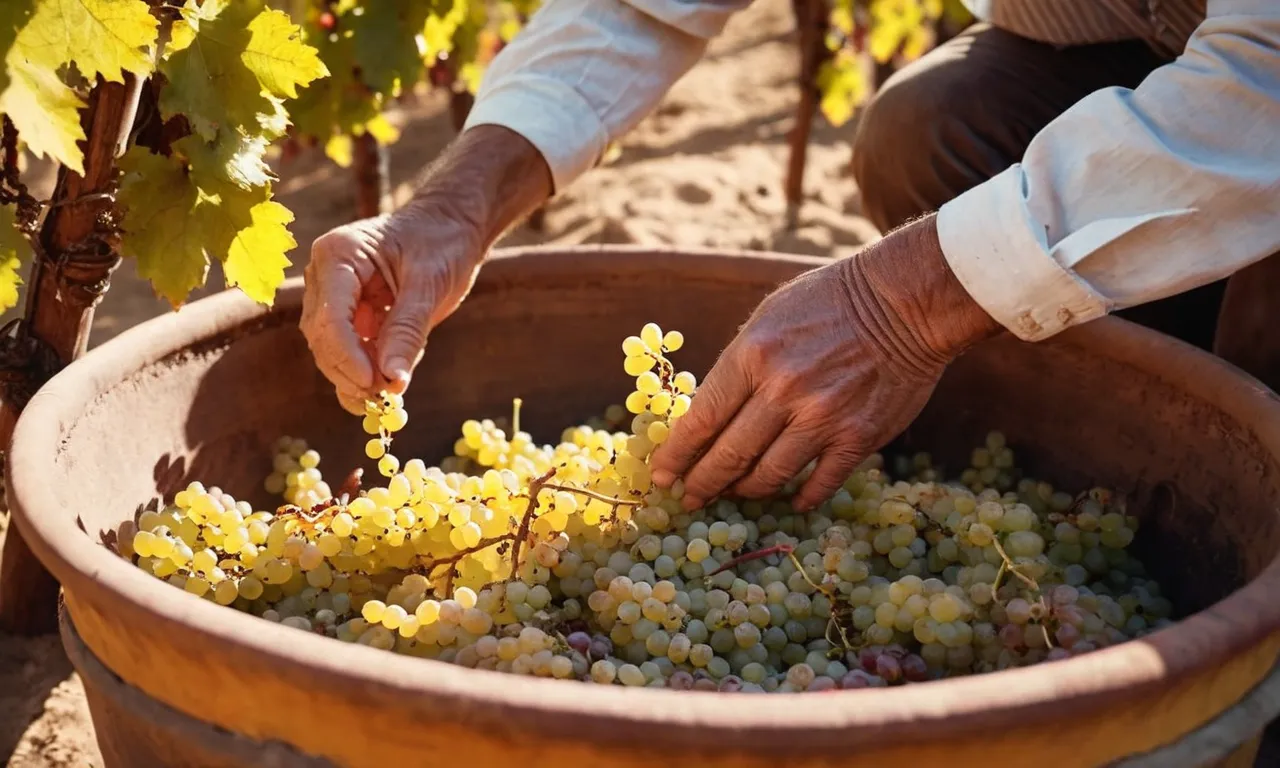How Did They Make Wine In Bible Times?
Winemaking has been an integral part of human civilization for thousands of years. Even in biblical times, wine was a common beverage that played an important role in religion and culture. If you’re short on time, here’s a quick answer to your question: Wine in the Bible was made by harvesting grapes, treading or pressing them to extract the juice, fermenting the juice naturally, and storing the wine in wineskins or jars.
The process was low-tech and simple, relying on natural yeasts and bacteria.
In this comprehensive guide, we will explore how ancient people in the Bible lands like Israel, Egypt, and Mesopotamia made wine without modern winemaking equipment. We will look at how and where they grew grapes, the winemaking techniques they used, the types of wines they produced, how wine was stored and aged, the role of wine in the Bible, and more.
Grape Cultivation in the Ancient World
The Origins of Grape Growing
Archaeological evidence suggests grapes were first domesticated around 6,000-8,000 years ago in the South Caucasus region, most likely in present-day Armenia, Georgia, Azerbaijan and parts of Iran and Turkey.
Early wine production began alongside cultivation as grapes were discovered to have suitable properties for fermentation. From this origin point, knowledge of viticulture spread through trade and cultural diffusion throughout the Mediterranean region and ancient Near East.
Grape Varieties and Growing Conditions
A vast diversity of Vitis vinifera grape varieties were developed and adapted to an array of microclimates and terrains in the ancient world. Popular ancient varieties included ancestry types for modern grapes like Sangiovese, Chardonnay and Cabernet Sauvignon.
Climate, soil composition, sunlight exposure, irrigation access and more impacted ideal grape varieties for a given area.
For example, hot, arid growing regions like Egypt and Canaan were suitable for thick-skinned Muscat grapes that retain water well. Cooler coastal areas like Greece favored thin-skinned varieties like the ancient progenitors of Nebbiolo and Riesling grapes.
High ground mountainsides offered good drainage as evidenced by ancient vineyards found at elevations as high as 1,000+ meters in Italy and Greece.
Viticulture and Vineyard Management
While wild grapes grow as crawling vines, ancient viticulturists discovered that grapevine growth and fruit yield can be greatly improved by trellising vines on wood structures and poles. This kept fruit off the ground and allowed better airflow and light exposure.
Other common viticulture practices included irrigation access, pruning, fertilization via composting and crop rotation schemes. In innovative areas, grafting rootstock to desired grape varieties became commonplace.
A range of protective measures were employed to avoid crop loss from threats like weather,disease, animals and theft. Vineyard sites offered natural barriers like slopes,walls and moats in some cases. Manual intervention like netting,traps and scarecrows helped as well.
The famous 125 BC Roman land survey De Agri Cultura recommended spring frosts be mitigated by controlled fires and smoke.
Winemaking Techniques in the Ancient World
Harvesting and Pressing Grapes
In Bible times, grape harvesting typically took place in late summer or early autumn when the grapes were ripe and sweet (Isaiah 18:5). Workers would carefully cut the clusters of grapes from the vines using a knife or sharp blade.
The harvested grapes were then placed in baskets or shallow trays and transported to the winepress.
The winepress consisted of a shallow upper vat and a lower vat. The upper vat was filled with the freshly picked grapes which would then be trampled by feet or pressed with a heavy beam to extract the sweet grape juice.
The juice would flow through a small opening into the lower vat where it could be collected (Nehemiah 13:15). This was very labor-intensive work!
Fermentation Vessels and Processing
After the grape juice was pressed, it would be poured into jars, wineskins, or clay amphorae to ferment. Over 4-6 weeks, the natural yeast on the grape skins would convert the sugars in the juice into alcohol (Matthew 9:17). This fermentation process was well understood in the ancient world.
The vessels were often sealed or covered during active fermentation. Then they would be opened to allow gasses to escape during the final stages of fermentation. Care was taken not to allow overexposure to oxygen which could spoil the wine.
Adding Flavors and Herbs
Spices, herbs, and fruits were often added to wines during fermentation or after to enhance the flavor. Some additives mentioned in ancient texts include honey, spices like myrrh and saffron, herbs such as thyme and sage, and fruits like pomegranates, apples, and raisins.
These flavorings served to make the sometimes tart homemade wine more palatable. The herbs and spices also acted as preservatives to prevent spoilage. So “mixed wine” enjoyed great popularity in Bible days (Proverbs 9:2).
Aging, Clarification, and Storage
Most ancient wines did not undergo aging like fine wines today. They were drunk relatively young within 1-3 years. But some wineries did lay down certain wines to maturity for later consumption or sale.
Wines would often be clarified after fermentation by racking to separate it from sediment or straining through cloth. Some wine was boiled briefly to hasten clarification. The clear wine could then be transferred to skin bags, clay jars or bottles for storage.
Jars would be sealed with clay or gypsum stoppers to preserve freshness.
Well-made wines if kept from air exposure would remain drinkable for years thanks to alcohol preservation and added flavorings. So really, many ancient winemaking techniques are still utilized even today! 🍇🍷
Types of Wines Produced in Biblical Times
Red, White, and Rose Wines
In ancient Israel, winemakers produced a variety of red, white, and rose wines from grapes grown in vineyards across the region. Red wines ranged from light and fruity to rich, full-bodied varietals. Popular red grape varieties included Grenache, Carignan, Cinsault, and Mourvedre.
These hardy, thick-skinned grapes produced darkly pigmented, intensely flavored wines. White wine grapes like Chardonnay and Sauvignon Blanc thrived in the Mediterranean climate, producing crisp, floral whites. Blending white juice with red grape skins resulted in pinkish rose wines.
Sweet, Dry, and Fortified Wines
Winemakers utilized different techniques to produce sweet, dry, and fortified wines. Adding grape juice before fermentation increased residual sugar for sweet, syrupy wines. Allowing yeasts to fully ferment grape sugars to alcohol resulted in dry table wines.
Fortifying wines by adding grape spirits during fermentation created robust, high-alcohol libations. Sweet wines were prized for ceremonial and celebratory occasions. Dry wines paired well with meals. Fortified wines boosted spirits and energized weary travelers.
Wine Blends and Additives
Skilled winemakers blended various grapes and experimented with additives to create unique, signature wines. Combining red and white varietals resulted in intricately flavored rosé wines. Expert vintners added honey, fruits, spices, or herbs to enhance a wine’s bouquet and taste.
Resins helped preserve and seal wines in clay jars and animal skins. However, most wines were unadulterated, reflecting the distinctive terroir of ancient Israel. Quality wines owed their complex character to mature, well-balanced grapes, meticulous winemaking, and judicious aging in underground cellars.
According to wine historians, ancient Israelites produced an impressive array of artisanal wines that were meaningful parts of daily life, religious rituals, and special events. While production methods were rudimentary compared to modern practices, skilled vintners crafted fine wines that have inspired millennia of wine enthusiasts, including the modern winemaking industry.
The Role and Significance of Wine in the Bible
Wine’s Religious and Cultural Importance
Wine held an important place in both the religious and cultural life of biblical times. As one of the principal agricultural products of ancient Israel and nearby regions, wine was seen as a gift from God (Psalm 104:15).
It was used in religious ceremonies and rituals to signify joy and blessings from the Lord (Deuteronomy 14:26). For example, drink offerings of wine accompanied many sacrifices at the Temple (Exodus 29:40).
Wine also had an important cultural role, being served at feasts and celebrations as a sign of hospitality, abundance and joy.
Wine in Biblical Feasts and Celebrations
Wine played a prominent role in the feasts and celebrations described in the Bible. At the Passover meal, each participant had four cups of wine to commemorate God’s deliverance of the Israelites from Egypt (Exodus 6:6-7).
Wine was also served at the feast following the completion of the Temple in Jerusalem, showing the people’s joy and gratitude to God (1 Kings 8:62-66). In Jesus’ first miracle, he turned water into wine at a wedding feast in Cana, saving the host from embarrassment and exemplifying God’s blessing (John 2:1-11).
Overall, wine was seen as part of occasions of fellowship, celebration and rejoicing in biblical accounts.
Wine’s Symbolic Meaning in Scripture
Beyond its practical functions, wine also carried rich symbolic meaning in the Bible. It was used to signify abundance, joy, and blessing from God. For example, the Promised Land was described as “flowing with milk and honey” – metaphors for lush, abundant vineyards and fig groves (Exodus 3:8).
Wine could also symbolize holiness and righteousness. Certain drinks were forbidden by biblical law, while wine use in religious ceremonies implied moral purity. Furthermore, an overflowing cup or vat of wine stood for God’s infinite lovingkindness and provision (Psalm 23:5).
However, wine’s effects could also mirror waywardness – overindulgence was seen as folly, while vinegar represented deterioration and sourness.
Storing and Serving Wine in Ancient Times
Wineskins
In ancient times, animal skins were commonly used as containers for storing and transporting wine. Goatskins were turned inside out, and the hair was removed. The skins were then tanned or treated to become watertight. These leather bags were called wineskins.
Wineskins provided a flexible, lightweight vessel that could hold 10-15 gallons of wine. As fermentation continued in the wineskin, carbon dioxide was released. This caused the wineskin to stretch. New wineskins could expand more easily without bursting. Old wineskins became brittle and inflexible.
Jesus used wineskins as an analogy in Matthew 9:17, saying, “Neither do people pour new wine into old wineskins. If they do, the skins will burst; the wine will run out and the wineskins will be ruined. No, they pour new wine into new wineskins, and both are preserved.”
Jars and Amphorae
For storing wine in large quantities, cylindrical clay jars and amphorae were commonly used. Amphorae had two handles and a long, narrow neck. These containers were made from clay, either molded by hand or on a wheel and then baked to harden them.
Amphorae varied in size from 2-5 gallons to over 7 gallons. Olive oil was also stored in amphorae.
In excavations, archaeologists have uncovered rooms lined with hundreds of ancient amphorae buried up to their necks in sand or stone. This allowed the jars to stand upright and be easily accessed. The cool underground temperatures helped preserve the wine.
The tomb paintings in the ancient Egyptian pyramids depict scenes of winemaking and large jars being filled and carried.
Additives to Preserve Wine
To prevent wine from souring, various preservatives and flavorings were added. Wine was boiled briefly to reduce the water content and concentrate the alcohol. Natural resins, such as pine and terebinth resin, served as a sealant to prevent oxygen from spoiling the wine.
Spices, herbs, or honey were sometimes mixed in as flavorings.
Isaiah 1:22 mentions wine “mixed with water.” This dilution likely occurred to moderate the strength of the wine. However, adding water increased the risk of bacteria and unfermented sugars turning the wine to vinegar.
Most ancient wine contained sediment from the grapes and was not clear like modern filtered wines.
Serving Vessels and Customs
In the Biblical era, wine was typically stored in large containers, then ladled into smaller serving vessels like cups and bowls for use at meals. In I Samuel 1:15, Hannah is found pouring her wine into a bowl to present at the tabernacle.
Both silver and pottery vessels for drinking wine have been found by archaeologists.
The man customarily oversaw serving the wine. A host ceremonially washing his hands and then pouring wine into the guests’ cups demonstrated hospitality. Jesus took on the role of a servant when he washed the disciples’ feet and served wine at the Last Supper.
While the Bible condemns drunkenness, wine in moderation was accepted and offered as an important sign of friendship, celebration, or consolation.
Conclusion
Wine has been a beloved beverage for millennia, and ancient people in Bible times put great effort into cultivating grapes and crafting quality wines. While their winemaking tools were rudimentary compared to modern methods, they nonetheless successfully produced a diverse range of wines that were integral to their culture, religion, and daily life.
The Bible contains many references to wine, underscoring its importance in ancient societies. Though the world of wine has evolved over the ages, its rich history can be traced back to the vineyards, presses, fermentation vessels and wineskins of the biblical era.








